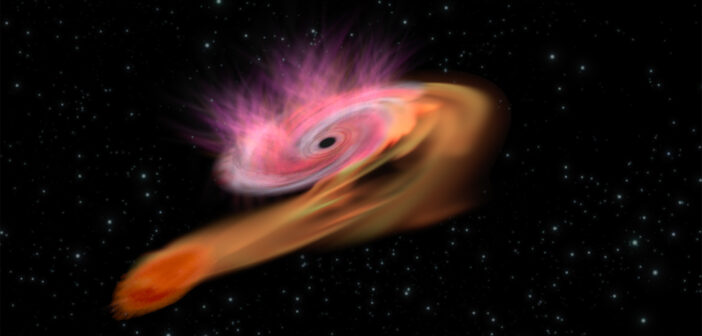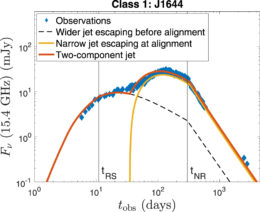When a star wanders too close to a supermassive black hole, the powerful tidal forces can rip the star apart. Tidal disruption events can produce powerful jets, but only sometimes — what determines whether a shredded star produces a jet?
A Star Disrupted

Illustration of shredded stellar material from a tidal disruption event. [Still image from an animation by NASA’s Goddard Space Flight Center/Chris Smith (USRA/GESTAR)]
Now, researchers have proposed a unified theory that may explain the variety of jet behaviors from tidal disruption events.
Aligning with a New Theory of Jet Production
In a recent research article, Odelia Teboul (The Hebrew University) and Brian Metzger (Columbia University and Flatiron Institute) proposed a new theory for why tidal disruption events are only rarely accompanied by jets. Teboul and Metzger suggested that only stars whose orbits are aligned with the black hole’s spin will produce jets when they are disrupted. Assuming that the stars in the dense neighborhood surrounding the supermassive black hole have orbits randomly oriented relative to the black hole’s spin, this means that only a tiny fraction of tidal disruption events should produce jets at the time of the event — just as we observe.
What about the tidal disruption events that exhibit jet-like emission months or years later? While only a small fraction of stars start out with their orbits aligned with the black hole’s spin, precession of the accretion disk that forms as the star is ripped apart can bring tilted stellar orbits into alignment with the black hole over time. How long this alignment process takes depends on the mechanism behind it: electromagnetic alignment takes weeks while hydrodynamic alignment takes months or years.Escape of the Jet Emission
Based on their simulations, Teboul and Metzger find that there are three broad classes of tidal disruption events with different observational signatures. In the first class, the jet escapes before alignment, producing prompt radio and X-ray emission. The X-ray emission varies as the system comes into alignment and dims after alignment. In the second class, the jet escapes as the system achieves alignment, again producing bright emission that grows fainter over time. In the third class, the jet’s escape is delayed, producing faint X-ray and radio emission months later.Teboul and Metzger found that faint, delayed jets should be much more common than bright, prompt jets, which is exactly what observations show. So perhaps jetted tidal disruption events aren’t as rare as previously thought — the majority of them are just late to the party.
Citation
“A Unified Theory of Jetted Tidal Disruption Events: From Promptly Escaping Relativistic to Delayed Transrelativistic Jets,” Odelia Teboul and Brian D. Metzger 2023 ApJL 957 L9. doi:10.3847/2041-8213/ad0037


